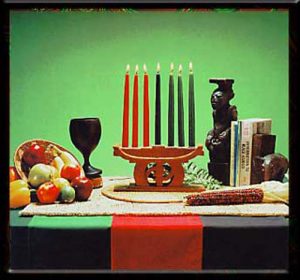Latest update February 13th, 2025 1:56 PM
Latest News
- GPHC fires senior doctor over stillbirth
- Despite not paying taxes, Exxon boss says profit sharing and royalty is same as giving Guyana tax
- ExxonMobil makes application for 8th oil project
- After Putin call, Trump says negotiations to end Ukraine war will start ‘immediately’
- Guyana captured by corrupt business and political elites
Kwanzaa observances end
Jan 03, 2017 News
Kwanzaa is an African cultural holiday. Celebrated from December 26, through January 1, its origins are in the first harvest celebrations of Africa from which it takes its name. The name Kwanzaa is derived from the phrase “matunda ya kwanza” which means “first fruits” in Swahil.
its origins are in the first harvest celebrations of Africa from which it takes its name. The name Kwanzaa is derived from the phrase “matunda ya kwanza” which means “first fruits” in Swahil.
Kwanzaa was initially put into motion by Dr. Maulana Karenga, in 1966.
Kwanzaa builds on the five fundamental activities of Continental African “first fruit” celebrations: ingathering; reverence; commemoration; recommitment; and celebration.
It is a time of gathering for family and community, coming together where people can renew and reinforce bonds between them. Kwanzaa is a time of special reverence for the Creator and creation, both a thanksgiving for the earth and a recommitment to protect and preserve it.
– a time of special reverence for the creator and creation in thanks and respect for the blessings, bountifulness and beauty of creation;
– a time for commemoration of the past in pursuit of its lessons and in honor of its models of human excellence, our ancestors;
– a time of recommitment to our highest cultural ideals in our ongoing effort to always bring forth the best of African cultural thought and practice; and
– a time for celebration of the Good – the good of life and of existence itself, the good of family, community and culture, the good of the awesome and the ordinary, in a word the good of the divine, natural and social.
The Principals of Kwanzaa are: 1. Umoja/Unity. 2.Kujichagulia/ Self-Determination. 3. Ujima/Collective work and responsibility. 4. Ujama/Cooperative Economics. 5. Nia/Purpose. 6. Kuumba/Creativity 7. Imani/Faith
Preparing for Kwanzaa
Before December 26, the first day of Kwanzaa, the day of Umoja or Unity, the entire house is cleaned. The home is then dressed in the colours of red, green and black. African motifs are often displayed along with other cultural articles.
The Kwanzaa table or corner is set up in the home. The table consists of the Kwanzaa symbols. First the straw mat is laid. On this mat rests the other symbols and articles. The candleholder with the seven candles is then placed on the mat, along with the bowl of fruits and ears of corn. Any other product which the family has produced during the year can also be displayed.
On the morning of December 26, the entire family gathers around the Kwanzaa table. Libations are offered to the creator and ancestors. The family then discusses failures and achievements in fostering unity in the family and community over the past year.
The candle of Umoja is then lit. It is important that the children and elders participate in the ceremony with the view of bridging the generational gap, thus continuing the tradition. If anyone has exemplified this principle during the previous year, Zwadis or gifts are given.
This ceremony is repeated with each principle being the center of discussing for the next seven days.
History of Kwanzaa in Guyana
Kwanzaa was introduced in Guyana in the 1970s. However, it did not become part of the African-Guyanese cultural calendar until 1992 when the newly formed African Cultural and Development Association (ACDA) revived the celebration and held its first observance.
It was held at several venues but is now held at ACDA’s Development Complex on Thomas Lands.
Share this:
- Click to print (Opens in new window)
- Click to email a link to a friend (Opens in new window)
- Click to share on Facebook (Opens in new window)
- Click to share on WhatsApp (Opens in new window)
- Click to share on Twitter (Opens in new window)
- Click to share on Pinterest (Opens in new window)
- Click to share on Pocket (Opens in new window)
- Click to share on Tumblr (Opens in new window)
- Click to share on Reddit (Opens in new window)
- Click to share on LinkedIn (Opens in new window)
Related
Similar Articles

The Glenn Lall Show|| February, 10th, 2025
Follow on Tik Tok @Glennlall
THE BLUNT OF THE DAY

Sports
Feb 13, 2025
2025 CWI Regional 4-Day Championships Round 3… -GHE (1st innings 87-4) Blades 3-15 Kaieteur Sports-Guyana Harpy Eagles were put on the back-foot early thanks to rain, coupled with a fiery spell...Features/Columnists
An Open Letter to the election observer missions
Peeping Tom… Kaieteur News-Later this year, you will arrive in Guyana as protectors of the integrity of our democracy.... more
OAS Secretary General Election and renewed OAS Consensus
Antiguan Barbudan Ambassador to the United States, Sir Ronald Sanders By Sir Ronald Sanders Kaieteur News- The upcoming election... more
Publisher’s Note
Freedom of speech is our core value at Kaieteur News. If the letter/e-mail you sent was not published, and you believe that its contents were not libellous, let us know, please contact us by phone or email.
Feel free to send us your comments and/or criticisms.
Contact: 624-6456; 225-8452; 225-8458; 225-8463; 225-8465; 225-8473 or 225-8491.
Or by Email: [email protected] / [email protected]
Weekend Cartoon















